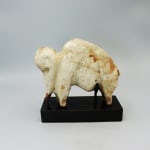Palaeolithic Sculpture of a Mammoth, 25000 BC - 10000 BC
Mammoth Ivory
13.5 x 5 x 16 cm
5 1/4 x 2 x 6 1/4 in
5 1/4 x 2 x 6 1/4 in
CC.74
Further images
-
(View a larger image of thumbnail 1
)

-
(View a larger image of thumbnail 2
)

-
(View a larger image of thumbnail 3
)

-
(View a larger image of thumbnail 4
)

-
(View a larger image of thumbnail 5
)

-
(View a larger image of thumbnail 6
)

-
(View a larger image of thumbnail 7
)

-
(View a larger image of thumbnail 8
)

-
(View a larger image of thumbnail 9
)

It is unclear what prompted humans to first engage in artistic expression, but it is apparent that it happened early in our history as a species. Certain artefacts dating from...
It is unclear what prompted humans to first engage in artistic expression, but it is apparent that it happened early in our history as a species. Certain artefacts dating from 230,000 years before present have been claimed as sculptures, though their shape may be due to natural weathering. The oldest confirmed sculptures, the Venus of Hohe Fels and the famous Löwenmensch (‘lion-man’), date to between 30,000 and 40,000 years ago. These earliest figures were carved in mammoth ivory, and may have had some kind of ritual or spiritual significance.
This magnificent representation of a mammoth is among the earliest art produced by human beings. Standing at 13 centimetres tall, it is unusually large for a figure of the period; other mammoth sculptures, found in the Vogelherd caves, are a mere 2.80cm in height. It is a triumphant expression of an animal of deep and abiding meaning for the people who hunted them. The social and spiritual importance of mammoths cannot be overestimated. Every part of the animal was used: tusks and skins were used to build shelters – the remains of which have been discovered in Russia, Ukraine, the Czech Republic, and southern Poland – the meat was consumed, the fur was used for clothing, the skin was tanned into leather, and tools were made from the bone and ivory. The form shows a skill for interpreting the essence of the creature: his round cranium, long tusks, humped back, pendulous stomach, strong legs and small triangular tail. The artist had a skill for observation, but also for abstraction and simplification, reducing him to his basic forms.
This sculpture represents a physical connection to the people of Spain, where it was discovered, during the earliest periods of the human habitation of Europe. It demonstrates the spark of human ingenuity and the capacity of human beings to interpret and define their world and the things in it. This sculpture has no practical purpose; either this was art for art’s sake, or this is evidence of spirituality at the earliest period of human history. Either way, it demonstrates the human need to create.
References: similar mammoth sculptures are known from excavations at the Vogelherd cave, in Brno in the Czech Republic (Institute of Archaeology) and in Tübingen (Museum der Universität Tübingen UFG-Äu-31/1-B).
This magnificent representation of a mammoth is among the earliest art produced by human beings. Standing at 13 centimetres tall, it is unusually large for a figure of the period; other mammoth sculptures, found in the Vogelherd caves, are a mere 2.80cm in height. It is a triumphant expression of an animal of deep and abiding meaning for the people who hunted them. The social and spiritual importance of mammoths cannot be overestimated. Every part of the animal was used: tusks and skins were used to build shelters – the remains of which have been discovered in Russia, Ukraine, the Czech Republic, and southern Poland – the meat was consumed, the fur was used for clothing, the skin was tanned into leather, and tools were made from the bone and ivory. The form shows a skill for interpreting the essence of the creature: his round cranium, long tusks, humped back, pendulous stomach, strong legs and small triangular tail. The artist had a skill for observation, but also for abstraction and simplification, reducing him to his basic forms.
This sculpture represents a physical connection to the people of Spain, where it was discovered, during the earliest periods of the human habitation of Europe. It demonstrates the spark of human ingenuity and the capacity of human beings to interpret and define their world and the things in it. This sculpture has no practical purpose; either this was art for art’s sake, or this is evidence of spirituality at the earliest period of human history. Either way, it demonstrates the human need to create.
References: similar mammoth sculptures are known from excavations at the Vogelherd cave, in Brno in the Czech Republic (Institute of Archaeology) and in Tübingen (Museum der Universität Tübingen UFG-Äu-31/1-B).
1
of
13








